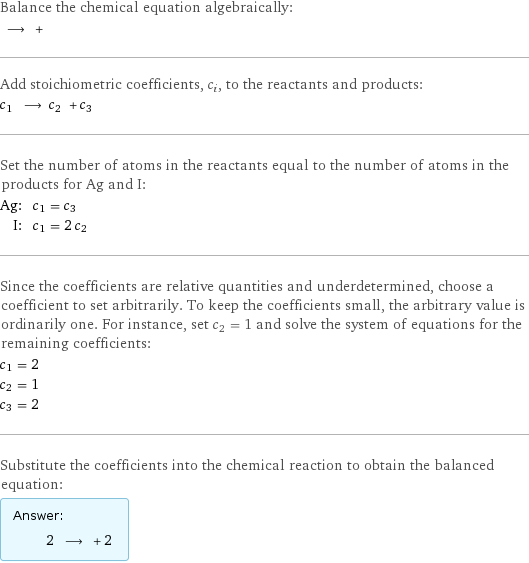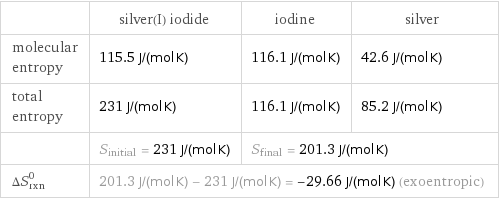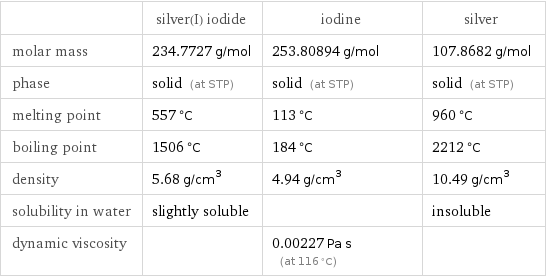Input interpretation

silver(I) iodide ⟶ iodine + silver
Balanced equation

Balance the chemical equation algebraically: ⟶ + Add stoichiometric coefficients, c_i, to the reactants and products: c_1 ⟶ c_2 + c_3 Set the number of atoms in the reactants equal to the number of atoms in the products for Ag and I: Ag: | c_1 = c_3 I: | c_1 = 2 c_2 Since the coefficients are relative quantities and underdetermined, choose a coefficient to set arbitrarily. To keep the coefficients small, the arbitrary value is ordinarily one. For instance, set c_2 = 1 and solve the system of equations for the remaining coefficients: c_1 = 2 c_2 = 1 c_3 = 2 Substitute the coefficients into the chemical reaction to obtain the balanced equation: Answer: | | 2 ⟶ + 2
Structures

⟶ +
Names

silver(I) iodide ⟶ iodine + silver
Reaction thermodynamics
Enthalpy

| silver(I) iodide | iodine | silver molecular enthalpy | -61.8 kJ/mol | 0 kJ/mol | 0 kJ/mol total enthalpy | -123.6 kJ/mol | 0 kJ/mol | 0 kJ/mol | H_initial = -123.6 kJ/mol | H_final = 0 kJ/mol | ΔH_rxn^0 | 0 kJ/mol - -123.6 kJ/mol = 123.6 kJ/mol (endothermic) | |
Entropy

| silver(I) iodide | iodine | silver molecular entropy | 115.5 J/(mol K) | 116.1 J/(mol K) | 42.6 J/(mol K) total entropy | 231 J/(mol K) | 116.1 J/(mol K) | 85.2 J/(mol K) | S_initial = 231 J/(mol K) | S_final = 201.3 J/(mol K) | ΔS_rxn^0 | 201.3 J/(mol K) - 231 J/(mol K) = -29.66 J/(mol K) (exoentropic) | |
Equilibrium constant
![Construct the equilibrium constant, K, expression for: ⟶ + Plan: • Balance the chemical equation. • Determine the stoichiometric numbers. • Assemble the activity expression for each chemical species. • Use the activity expressions to build the equilibrium constant expression. Write the balanced chemical equation: 2 ⟶ + 2 Assign stoichiometric numbers, ν_i, using the stoichiometric coefficients, c_i, from the balanced chemical equation in the following manner: ν_i = -c_i for reactants and ν_i = c_i for products: chemical species | c_i | ν_i | 2 | -2 | 1 | 1 | 2 | 2 Assemble the activity expressions accounting for the state of matter and ν_i: chemical species | c_i | ν_i | activity expression | 2 | -2 | ([AgI])^(-2) | 1 | 1 | [I2] | 2 | 2 | ([Ag])^2 The equilibrium constant symbol in the concentration basis is: K_c Mulitply the activity expressions to arrive at the K_c expression: Answer: | | K_c = ([AgI])^(-2) [I2] ([Ag])^2 = ([I2] ([Ag])^2)/([AgI])^2](../image_source/b8fac2cdf86df7386198a6abcd5ec2f1.png)
Construct the equilibrium constant, K, expression for: ⟶ + Plan: • Balance the chemical equation. • Determine the stoichiometric numbers. • Assemble the activity expression for each chemical species. • Use the activity expressions to build the equilibrium constant expression. Write the balanced chemical equation: 2 ⟶ + 2 Assign stoichiometric numbers, ν_i, using the stoichiometric coefficients, c_i, from the balanced chemical equation in the following manner: ν_i = -c_i for reactants and ν_i = c_i for products: chemical species | c_i | ν_i | 2 | -2 | 1 | 1 | 2 | 2 Assemble the activity expressions accounting for the state of matter and ν_i: chemical species | c_i | ν_i | activity expression | 2 | -2 | ([AgI])^(-2) | 1 | 1 | [I2] | 2 | 2 | ([Ag])^2 The equilibrium constant symbol in the concentration basis is: K_c Mulitply the activity expressions to arrive at the K_c expression: Answer: | | K_c = ([AgI])^(-2) [I2] ([Ag])^2 = ([I2] ([Ag])^2)/([AgI])^2
Rate of reaction
![Construct the rate of reaction expression for: ⟶ + Plan: • Balance the chemical equation. • Determine the stoichiometric numbers. • Assemble the rate term for each chemical species. • Write the rate of reaction expression. Write the balanced chemical equation: 2 ⟶ + 2 Assign stoichiometric numbers, ν_i, using the stoichiometric coefficients, c_i, from the balanced chemical equation in the following manner: ν_i = -c_i for reactants and ν_i = c_i for products: chemical species | c_i | ν_i | 2 | -2 | 1 | 1 | 2 | 2 The rate term for each chemical species, B_i, is 1/ν_i(Δ[B_i])/(Δt) where [B_i] is the amount concentration and t is time: chemical species | c_i | ν_i | rate term | 2 | -2 | -1/2 (Δ[AgI])/(Δt) | 1 | 1 | (Δ[I2])/(Δt) | 2 | 2 | 1/2 (Δ[Ag])/(Δt) (for infinitesimal rate of change, replace Δ with d) Set the rate terms equal to each other to arrive at the rate expression: Answer: | | rate = -1/2 (Δ[AgI])/(Δt) = (Δ[I2])/(Δt) = 1/2 (Δ[Ag])/(Δt) (assuming constant volume and no accumulation of intermediates or side products)](../image_source/bb1f5218c7f78b4eb755c01d92ccdcf9.png)
Construct the rate of reaction expression for: ⟶ + Plan: • Balance the chemical equation. • Determine the stoichiometric numbers. • Assemble the rate term for each chemical species. • Write the rate of reaction expression. Write the balanced chemical equation: 2 ⟶ + 2 Assign stoichiometric numbers, ν_i, using the stoichiometric coefficients, c_i, from the balanced chemical equation in the following manner: ν_i = -c_i for reactants and ν_i = c_i for products: chemical species | c_i | ν_i | 2 | -2 | 1 | 1 | 2 | 2 The rate term for each chemical species, B_i, is 1/ν_i(Δ[B_i])/(Δt) where [B_i] is the amount concentration and t is time: chemical species | c_i | ν_i | rate term | 2 | -2 | -1/2 (Δ[AgI])/(Δt) | 1 | 1 | (Δ[I2])/(Δt) | 2 | 2 | 1/2 (Δ[Ag])/(Δt) (for infinitesimal rate of change, replace Δ with d) Set the rate terms equal to each other to arrive at the rate expression: Answer: | | rate = -1/2 (Δ[AgI])/(Δt) = (Δ[I2])/(Δt) = 1/2 (Δ[Ag])/(Δt) (assuming constant volume and no accumulation of intermediates or side products)
Chemical names and formulas

| silver(I) iodide | iodine | silver Hill formula | AgI | I_2 | Ag name | silver(I) iodide | iodine | silver IUPAC name | silver iodide | molecular iodine | silver
Substance properties

| silver(I) iodide | iodine | silver molar mass | 234.7727 g/mol | 253.80894 g/mol | 107.8682 g/mol phase | solid (at STP) | solid (at STP) | solid (at STP) melting point | 557 °C | 113 °C | 960 °C boiling point | 1506 °C | 184 °C | 2212 °C density | 5.68 g/cm^3 | 4.94 g/cm^3 | 10.49 g/cm^3 solubility in water | slightly soluble | | insoluble dynamic viscosity | | 0.00227 Pa s (at 116 °C) |
Units
